Researchers from the Fraunhofer Institute for Machine Tools and Forming Technology IWU, in Germany, have recently announced that they were able to develop a new method of cutting steel. The technique relies solely on the use of electromagnetic fields, a feat that could mean a world of difference for the automotive industry, as an example. In these instances, high-strength steels need to be produced accurately, but the process also involved punching holes in them, which proves to be very difficult. The German innovation could see this issue taken care of, PhysOrg reports.
Sticking to vehicles, in the case of an accident, the steel making up the bodywork needs to be strong enough to withstand the brute force of the impact. Creating such strong alloys is a challenge in itself, but even companies producing these vehicles have a hard time when it comes to piercing the shell, such as when it's time to place electrical wires through the frame. Mechanical drilling tools, which are currently the standard for such operations, wear out in a matter of days or weeks, and need to be replaced, forcing companies to pay large sums of money for this.
Additionally, this method leaves behind what experts refer to as burr, debris that clogs the drilled surfaces. Further time and money need to be spent on the finishing process. Lasers are a possible solution, but they consume vast amounts of electricity. Now, the Fraunhofer team has developed this new approach, which promises to leave all these problems behind. “The new method is based on electromagnetic pulse technology (EMPT), which was previously used primarily to expand or neck aluminum tubes. We’ve modified it to cut even hard steels. Whereas a laser takes around 1.4 seconds to cut a hole, EMPT can do the job in approximately 200 milliseconds – our method is up to seven times faster,” IWU Head of Department Dr. Verena Krausel explains.
The innovation eliminates the need for the finishing stage of the production process, and eases the job for the presses, which can work for longer without needing to have parts replaced. Speaking about the impact that the electromagnetic fields have on the steels, the expert adds that, “The impact pressure on the steel is approximately 3,500 bar, which equates to the weight of three small cars on a single fingernail.” She says that the original EMPT system, which was modified to cut through steel, has been provided by Alenzau, Germany-based PSTproducts GmbH.

 14 DAY TRIAL //
14 DAY TRIAL //